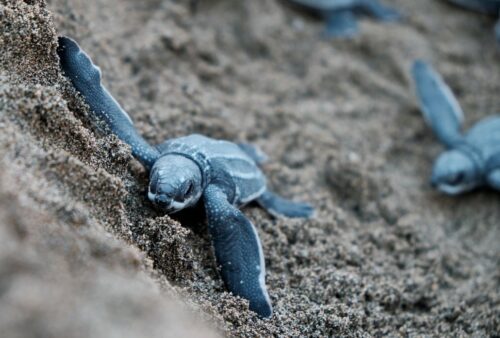Image Courtesy of Joko Diaz.
Pictured above is a baby leatherback turtle, a deep-diving reptile that lives in the ocean for years but migrates to the land to lay eggs. Leatherbacks have sleek, paddle-like forelimbs to navigate the seas, claws to walk on sand, and a mosaic of breathable cartilage for a shell. Many such adaptations have made turtles the masters of their niche between the land and the sea for over 200 million years. Accordingly, when engineers Robert Baines and Sree Kalyan Patiballa sat down to ideate a multi-environment mobile robot, they drew inspiration from turtle body plans and kinematics and named their robot the Amphibious Turtle Robot, or ART.
“The importance of the paper is that we are showcasing how you can have robots that have adaptive components—components that change shape, and how this design paradigm can improve their efficiency and effectiveness,” says Baines, a PhD student researcher in Rebecca Kramer-Bottiglio’s lab at Yale, describing the lab’s recent Nature publication. ART is a quadruped with a streamlined shell, weighs nine kilograms, and has a body amalgamating soft materials that respond to external stimuli and traditional, rigid robotics components. The most remarkable feature of the robot is its morphing limbs that undergo adaptive morphogenesis—the limbs can alter their gait or shape in response to a stimulus, adopting morphologic features that best suit aquatic and terrestrial locomotion. For example, the limbs can morph into the streamlined flippers of a sea turtle when in water and the columnar legs of a land-faring tortoise when walking.
While rigid-bodied robots can be programmed to perform a single task efficiently, they do not afford the same body compliance needed to design bio-inspired robots with muscle-like actions. Soft materials also have move-and-hold operability–these materials can retain changes in shape without the constant application of external force, enhancing the overall energy efficiency of the robot.
The best metric for ART’s performance was the Cost of Transport (COT), which measures the effectiveness of robot locomotion in terms of energy efficiency. ART had a minimum COT of three and ten for aquatic and terrestrial locomotion, respectively–a number that equals or outperforms other famous unimodal quadrupeds like EPFL’s Cheetah Cub and the Titan V-III.
However, many improvements must be made before the robot is put to commercial use, especially when it comes to untethering. “One of the things we’re moving forward with is putting additional sensors on the robot to understand how it’s moving in the environment,” Baines said. “This way, it would know, for example, if it were in choppy water or still water, or if it were going down a hill and stumbling versus being stable and standing on flat ground.” The lab is also working to find better gaits for the robot.
Even with such challenges, Baines foresees several important applications of such robots in the near future. Robots such as ART can be used to monitor ecosystems less invasively. “Such a platform is unique because it is bio-inspired. It would have less disturbance on the environment and the animals living in it,” Baines said. Instead of using turbulent propellers, the turtle robot swims using streamlined flippers. This design paradigm also foreshadows advances in disaster relief distribution, security, and the study of animal locomotion physics.

